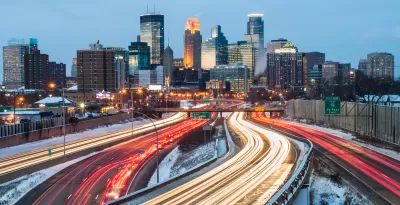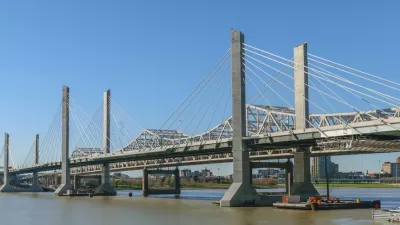Democratic Gov. Tim Walz, who took office on Jan. 7, wants to hike the state's 28.6-cents gas tax, 15% lower than the national average, so cities like Duluth won't have to ask voters to pass sales tax increases to fund local road repairs.

Democratic Governor Tim Walz, who campaigned on increasing the gas tax to invest in roads, highways and bridges, "is bracing for his first battle with Republicans when it comes to his gas tax proposal," states Anthony Matt for KBJR News.
“It’s a non-starter. Especially with a $1.5 billion surplus,” said Sen. Justin Eichorn, R – Grand Rapids.
Governor Walz says he wants the [possibly 10-cent gas tax] increase, because, as he says, Minnesota has an $18 billion transportation need over the next 20 years.
The gas tax is over a nickel lower than the national average according to API. Looking at the Tax Foundation's July 2018 gas tax map, it is lower than three of its four neighboring states as well as the Canadian provinces of Manitoba and Ontario to the north.
Governor Walz says he doesn’t want to see cities do what Duluth is trying to do, which is a half-percent sales tax increase to fund road repairs...
“The situation that happened in Duluth, it’s going to happen in Mankato, then it’s going to happen in Winona. And the real sad part is, when it starts happening in smaller communities like St. James, they don’t have the tax base to do what Duluth did. And then we have a crumbling infrastructure, which drives business away, and drives opportunity away,” said Walz.
Duluth voters overwhelmingly approved a half-cent sales tax in November 2017 to fund road repairs, but it was unable to get needed authorization by the state legislature before they adjourned last May.
"According to a study done by the Humphrey School of Public Affairs [University of Minnesota] in the Twin Cities, our gas tax currently makes up about 20% of the state’s transportation revenue," states Jessie Slater of KBJR News in the same broadcast. From the study:
[Researchers] most significant finding is that a huge percentage of transportation infrastructure in Minnesota is funded by local governments [pdf] —primarily through the property taxes they collect—rather than by the state and federal governments, the gasoline tax, and other funding, says Associate Professor Zhirong (Jerry) Zhao.
"Walz says if Republicans don’t want it, provide an alternative solution," adds Matt.
“I’m open to your (Republicans) proposals. They may propose things that I disagree with, like toll roads, but I’ll listen to them,” said Walz.
Historically, it's been politically difficult to increase the gas tax in the North Star State, though not necessarily on account of the legislature.
In Part 4 (posted here) of his eight-part series on the August 1, 2007 collapse of the I-35W Mississippi River Bridge that killed 13 people, University of Minnesota Civil Engineering Professor David Levinson recounts Republican Gov. Tim Pawlenty's three vetoes of legislative gas tax increases: in 2005; May 15, 2007, and 2008. The legislature overrode the final veto, adding a five-cents-per-gallon gas tax plus debt surcharge increments amounting to 3.5 cents [pdf], the last of which occurred in 2012.
In 2013, Democratic Gov. Mark Dayton told Democratic legislators, who controlled both branches of the state legislature, that he would not support their 7.5-cents per gallon tax hike because he felt it lacked popular support. He had a change of mind two years later, but by then, Republicans took control of the House.
Related: Minnesota Gubernatorial Candidate Campaigned on Increasing the Gas Tax and Wins, November 23, 2018.
Hat tip to AASHTO Daily Transportation Update.
FULL STORY: Walz pushing for gas tax increase

Planetizen Federal Action Tracker
A weekly monitor of how Trump’s orders and actions are impacting planners and planning in America.

San Francisco's School District Spent $105M To Build Affordable Housing for Teachers — And That's Just the Beginning
SFUSD joins a growing list of school districts using their land holdings to address housing affordability challenges faced by their own employees.

The Tiny, Adorable $7,000 Car Turning Japan Onto EVs
The single seat Mibot charges from a regular plug as quickly as an iPad, and is about half the price of an average EV.

Seattle's Plan for Adopting Driverless Cars
Equity, safety, accessibility and affordability are front of mind as the city prepares for robotaxis and other autonomous vehicles.

As Trump Phases Out FEMA, Is It Time to Flee the Floodplains?
With less federal funding available for disaster relief efforts, the need to relocate at-risk communities is more urgent than ever.

With Protected Lanes, 460% More People Commute by Bike
For those needing more ammo, more data proving what we already knew is here.
Urban Design for Planners 1: Software Tools
This six-course series explores essential urban design concepts using open source software and equips planners with the tools they need to participate fully in the urban design process.
Planning for Universal Design
Learn the tools for implementing Universal Design in planning regulations.
Smith Gee Studio
City of Charlotte
City of Camden Redevelopment Agency
City of Astoria
Transportation Research & Education Center (TREC) at Portland State University
US High Speed Rail Association
City of Camden Redevelopment Agency
Municipality of Princeton (NJ)




























